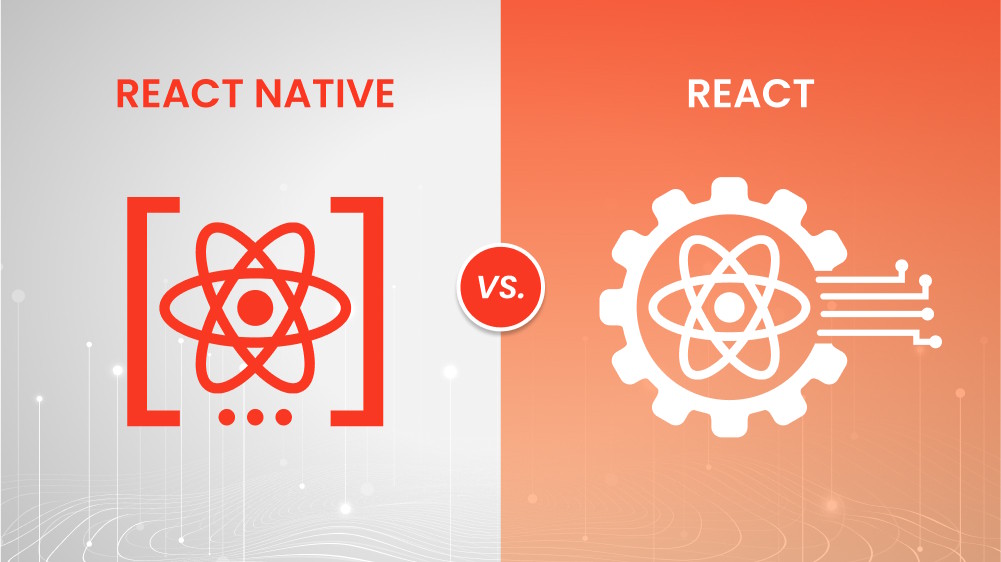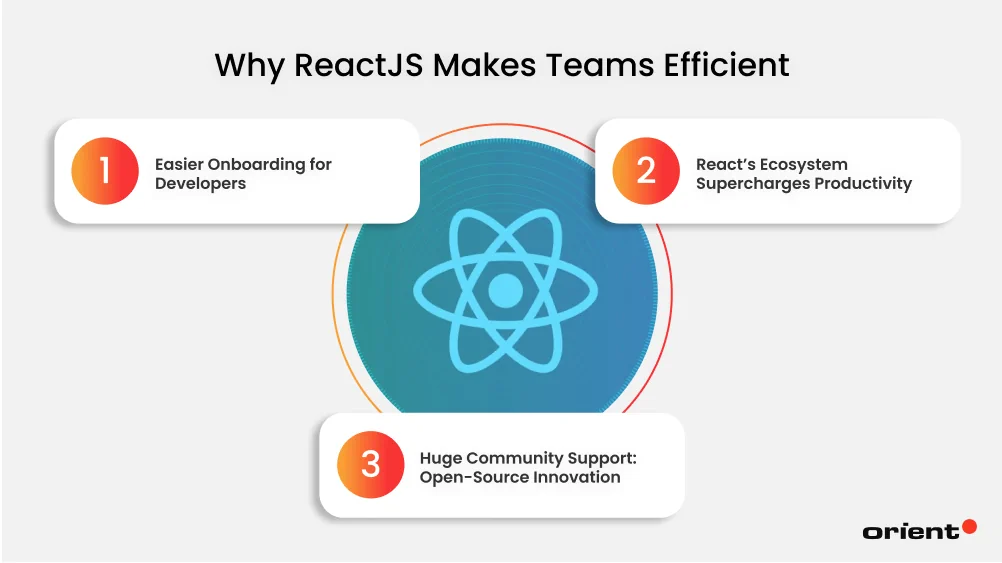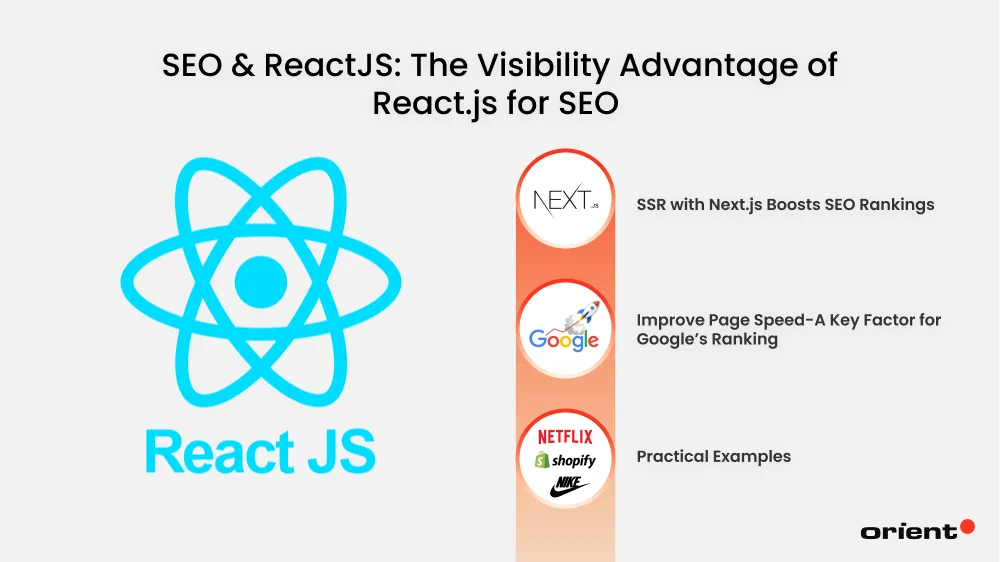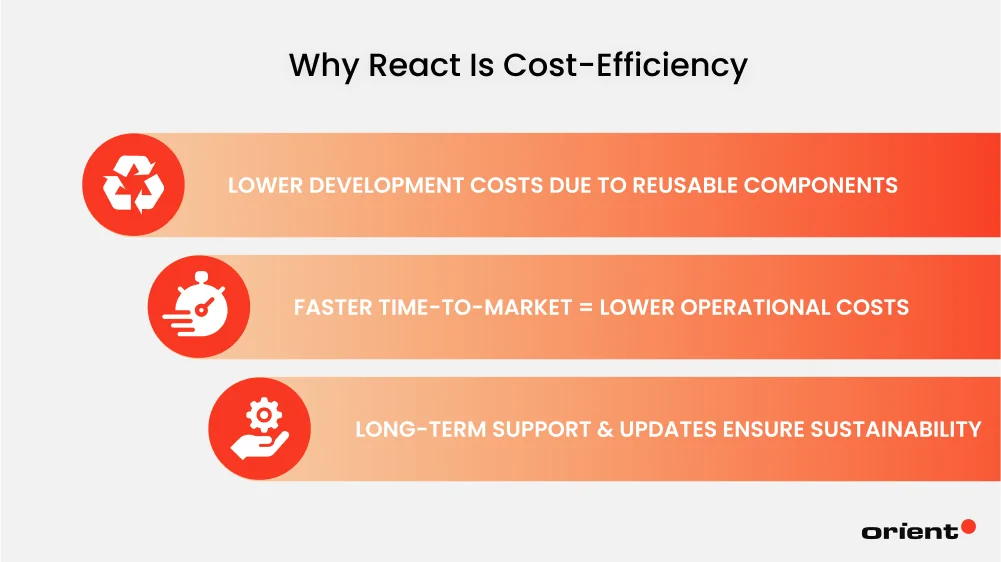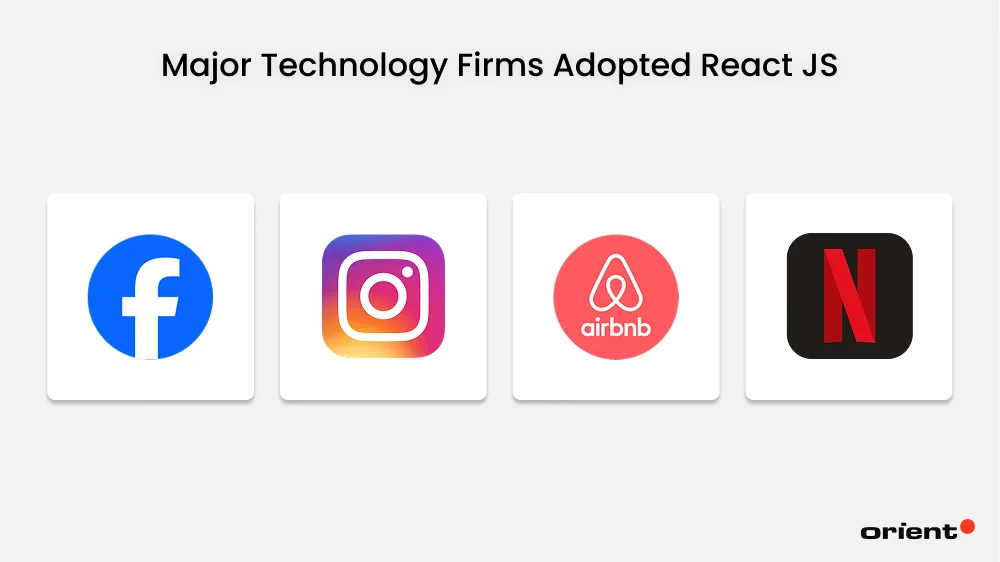React JS functions as a powerful framework that has entirely changed the development process of user interfaces. Facebook created React JS at first, but this JavaScript library has gone on to become one of the most popular tools that drives the operation of more than 11 million websites globally. The component-based architecture, alongside its virtual DOM, functions as a core reason why businesses prefer using React JS to design efficient, high-performance, scalable applications.
Beyond its technical advantages, React JS offers substantial profit-driven benefits. Businesses that use React JS for building web and mobile applications achieve 40% lower development costs compared to conventional techniques. The reusable component components in its architecture enable quicker development with shorter time-to-market distributions. The market leadership of React JS stands firm as it possesses a 5.9% domination rate of all JavaScript libraries, which confirms its future-ready position for business operations.
Large companies such as Netflix, Airbnb, and Instagram rely on React JS to enhance their customer experience delivery. The number of developer downloads at NPM demonstrates widespread developer popularity, reaching over 22 million weekly downloads, which reflects its strong community support. When businesses implement React JS, they can achieve technical enhancement alongside cost savings and enhanced user engagement, as well as quicker development times for digital transformation success.
The following piece analyzes the benefits of React JS by showing its advantages and disadvantages, which will provide a clear image of its technical brilliance and its capability to boost business revenue.
The Strategic Appeal of ReactJS
Major enterprises have widely accepted ReactJS, which is not a coincidence because its combination of cost-saving abilities and scalable framework alongside developer-friendly features provides exceptional value.
Facebook developed ReactJS as an open-source JavaScript library that helps developers produce interactive user interfaces for single-page applications (SPAs) while maintaining dynamic behavior. A component-based architecture found in ReactJS enables programmers to develop reusable front-end building blocks, which improves development speed along with better code organization. ReactJS works with a virtual DOM (Document Object Model) system to enhance performance because it will only refresh necessary components without forcing a full page reload.
The most attractive feature of ReactJS is its state management system, which becomes simpler through its declarative approach. The development process involves describing target results to ReactJS, which automatically handles the efficient rendering of updates. The server-side rendering (SSR) functionality of ReactJS allows web pages to load quickly while search engines better index content, which enhances the SEO performance.
The one-way data binding mechanism of React takes state changes in components and automatically updates the user interface unless unintended behavioral effects occur. The feature substantially contributes to debugging procedures along with serving as an essential tool for maintaining application stability. The framework works well with Redux and Next.js because these tools enable advanced state management together with optimized performance optimization and routing capabilities.
Performance Without Complexity: Why ReactJS Wins
![Performance Without Complexity: Why ReactJS Wins]()
Virtual DOM’s Efficiency: Faster Page Loads & Better UX
The virtual DOM represents ReactJS’s most groundbreaking feature since it drops webpage reloads in favor of changing component updates for better performance. Web frameworks that operate traditionally demand direct DOM modification, which proves slow and uses high resource quantities. As a lightweight abstraction, the virtual DOM processes two states against one another to determine the smallest required updates that increase application performance.
Advanced page loading speed occurs from this mechanism, which provides a seamless, responsive application experience. UI speed increases lead to superior user experiences through the elimination of delays that should mainly affect complex applications needing regular interface updates. Website users tend to stay longer when pages fulfill a three-second load requirement, resulting in a 40% decrease in bounce rates because of React’s Virtual DOM performance enhancement.
The capability of ReactJS to minimize wasteful re-rendering activities helps decrease CPU utilization, which makes it the perfect technology for applications running on systems with restricted processing abilities, such as mobile platforms.
Component-Based Development: Easier Maintenance & Scalability
The component-based structure in ReactJS transforms developer approaches to building application structures. The core principle of React involves developing programs through discrete components that function separately from one another. The chosen methodology promotes code consistency together with modularity features that facilitate easier debugging, thus enabling simpler long-term maintenance.
For example, a complex e-commerce application is built with three independent components, including shopping cart code and product listings with a detached user profile framework. The separate components in this system function independently while providing faultless integration to allow easy updates and resource flexibility. Each developer maintains their focus on the particular feature because they only need to update the matching component.
The development process becomes faster through the reuse of individual project elements. The creation of pre-built components by companies generates a library that teams utilize to reuse interfaces instead of developing them fresh for new projects. The practice minimizes production expenses while also offering a standardized product appearance throughout several platforms.
ReactJS Makes Teams Efficient
![ReactJS Makes Teams Efficient]()
Easier Onboarding for Developers
Onboarding new developers becomes smoother through ReactJS, which provides a simplified learning experience. ReactJS stands out from complex platforms since it features a lightweight structure with intuitive component-based design, which enables developers to understand core elements efficiently.
Using declarative syntax proves to be an appealing programming method in ReactJS since it enables developers to achieve predictable and straightforward UI development. The DOM stays out of developers’ hands because they detail their desired UI outcome, and React performs the state modifications automatically. The method enables enhanced code stability while lowering bug occurrences and delivering predictable outcomes.
The modular structure of React enables new team members to understand component parts independently from a complete application understanding. When developers work on individual features, they can avoid becoming overwhelmed by an extensive codebase.
The official documentation of React provides updated, clear content for beginners with practical use cases and solution advice. Developers gain faster project entrance when working with React because of the wide range of tutorials, bootcamps, and online courses available.
React’s Ecosystem Supercharges Productivity
The ReactJS framework works in an ecosystem that includes multiple powerful tools that both boost development speed and smooth workflow operations. The integration of the following technologies has brought the most meaningful impact to React developers:
- Next.js – stands as an ecosystem-optimized React framework that adds SSR and static site generation (SSG) capabilities for optimized performance as well as enhanced SEO results. The Next.js framework gives businesses quick page loads combined with superior search engine results and built-in functions that handle image optimization.
- Redux – provides businesses with a dependable state management method that enhances application data synchronization between components. Redux streamlines prop drilling operations and facilitates easy state alterations, thereby enabling more scalable and manageable app development.
- React Query – provides powerful features for API call management and background data maintenance, which reduces the complexity of API handling. The performance of applications improves through React Query because it handles background data operations automatically while decreasing repetitive network connections.
React offers built-in debugging tools, such as the React Developer Tools extension for Chrome and Firefox. Through these tools developers obtain easy access to component hierarchies along with state change monitoring capabilities. Quick debugging processes help developers discover problems more efficiently which produces applications of high quality.
Huge Community Support: Open-Source Innovation
Having an extensive global developer base supports ReactJS as one of the most widely backed JavaScript libraries today. Millions of developer contributions to open-source projects allow businesses that use ReactJS to adopt state-of-the-art developments without repeating development from scratch.
The main benefit of having an open-source platform like React is access to an abundant collection of third-party libraries and components. Developers can access ready-made third-party solutions through the React ecosystem for any functionality need without needing to start from basic codes.
Modern programming forums, including GitHub, along with Stack Overflow and Dev.to, give developers quick access to obtain expert guidance and problem-solving recommendations along with best practices so problems are addressed more efficiently and quickly. The adoption of React leads organizations beyond the acquisition of technology because it immerses them within a community that fosters rapid advances and promotes enduring development.
ReactJS establishes itself as one of the leading modern web development frameworks because it uses developer efficiency along with powerful integration and enthusiastic community engagement. The technology allows companies to achieve higher team productivity levels alongside excellent application quality, which results in its popularity as a smart scaling solution for businesses.
SEO & ReactJS: The Visibility Advantage of React.js for SEO
![ReactJS Makes Teams Efficient]()
SSR with Next.js Boosts SEO Rankings
The main obstacle with JavaScript-based web applications concerns their search engine optimization capabilities. The core strength of ReactJS as a UI development tool conflicts with poor search engine indexing because its standard client-side rendering method (CSR) creates difficulties for search crawlers. A React framework named Next.js provides solutions for these optimization needs.
Next.js allows pages to undergo server-side rendering (SSR), allowing server pre-generation before browser transfer. Next.js delivers complete site content to search engines at indexing time because it renders the app before Google and other search engines crawl it. SSR through Next.js dramatically enhances SEO ranking performance because it provides direct access for search algorithms to pages on websites.
Additionally, Next.js delivers static site generation (SSG) as part of its tools, which allows pages to be built beforehand to ensure immediate user load times. Next.js enables React businesses to gain better organic search results, which leads to higher website traffic and increased conversions.
Improve Page Speed—A Key Factor for Google’s Ranking
Higher search rankings in Google search results belong to websites that deliver quick page loading times. Numerous performance optimization methods found in ReactJS enable better application performance:
- The virtual DOM system in React performs enhancements to minimize useless updates, which results in sped-up rendering time and applications that feel more responsive to users.
- React allows developers to implement lazy loading functionality through which components dynamically fetch and load only the parts of webpages that users require. The initial load time shortens significantly, which leads to a better user experience.
- Image optimization features automatically integrate into React applications when they use Next.js as a framework. The framework uses its compression features to transform images into WebP format, thus minimizing bandwidth and improving page loading times.
Research reveals that pages requiring three seconds or less to load lead to a substantial reduction in bounce rates; thus, React-fueled applications provide better retention of visitors who simultaneously gain improved search engine positioning.
Practical Examples
Numerous major companies have used ReactJS alongside Next.js to improve their search engine visibility.
The utilization of React by Netflix enables smooth and fast interfaces, which enhance user browsing speed without delay issues. Next.js optimization allows Netflix to achieve better positions in streaming-related search results, which results in a substantial organic traffic increase.
Shopify accomplishes fast product details accessibility through its integration of React and Next.js technology for e-commerce purposes. The speed of React-based applications leads users to engage more with content while making more purchases, which proves that React applications directly affect website search rankings.
Fast rendering capabilities from React enable Nike to deliver quick webpage loads throughout its global retail store, thus improving customer browsing speed. The focus on performance gives Nike a dominant position in search results for athletic sports products.
Businesses benefit from a solid competitive advantage through the implementation of ReactJS with Next.js to improve their digital presence. Companies using speed enhancements and server-side rendering in combination with industry-leading optimization tools will boost search rankings, through which they achieve increased organic traffic that leads to better customer engagement and conversion rates.
Why Businesses Save Money with React
![Why Businesses Save Money with React]()
Lower Development Costs Due to Reusable Components
The component-based design of ReactJS represents a major cost-saving feature because developers can use these elements throughout multiple applications. Through the use of pre-built components, businesses can reduce development expenses as well as cut down on development time.
For example, a company that builds multiple web applications can develop a standard component library for buttons, forms, navigation bars, and cards and merge them without issues through various projects. The platform speeds up development while minimizing support expenses because updated elements spread to all system instances that employ them.
Additionally, the modular structure of this approach enables scalability due to its design. The expansion of businesses through platform growth enables them to save development costs by just extending already existing React components.
Faster Time-to-Market = Lower Operational Costs
ReactJS delivers time-efficient application deployment to business clients while maintaining application quality standards. The features of hot reloading, as well as declarative syntax combined with robust debugging tools and efficient development processes within React, let teams develop applications at a high speed while meeting deadlines.
A new SaaS platform startup can enhance development velocity thanks to React components that repeat and state management capabilities from Redux or React Query. Next.js works seamlessly with React’s ecosystem to provide SSR capabilities that enhance performance through optimized backend operations and shorter page load times, which improve both operational efficiency and customer retention.
Business operations benefit from shorter development timelines because they spend less money on personnel along with hosting expenses and direct additional funds toward organizational expansion approaches.
Long-Term Support & Updates Ensure Sustainability
Implementing sustainable frameworks remains vital for businesses that want to evade the costs of moving between systems and implementing major alterations. Continuous updates as well as security enhancements from Meta and its vast open-source community enable companies to escape unexpected technical debt.
The availability of forward compatibility within React makes the transition successful between software versions to keep all current features working, which greatly decreases operational expenses. Users of React benefit from a community-based development model that provides ready-made solutions and documentation alongside integration capabilities, so internal development teams require less support.
React Native compatibility becomes a top choice for enterprises because it enables them to create web and mobile applications from one shared codebase, which avoids future development costs through separate teams.
The integration of ReactJS into businesses achieves three key benefits: lowering costs, expediting deployment rates, and creating durable solutions that preserve high performance and scalability in the applications.
Who Adopted ReactJS?
![Who Adopted ReactJS?]()
Numerous technology firms at the global level use ReactJS as strong evidence that validates both its fundamental features and strategic business tools.
Facebook (Meta)
As the creator and primary maintainer of ReactJS, Meta (formerly Facebook) deeply integrates the React library throughout its core platforms. Facebook relies on React to power its main news feed functionality and complex ad platforms alongside thousands of additional interactive parts in the system. The development of React arose because Facebook needed to create interactive and high-performance user interfaces for its fast-changing web application with large amounts of data. The component-driven framework inside React enables their big teams to develop separately on different features, thus improving the scalability and maintenance of their big codebase. Billions of users receive a fluid and responsive user experience because the virtual DOM provides outstanding efficiency when users encounter dynamically updating content.
Instagram
Instagram, also part of Meta, leverages React extensively for its web platform. The smooth transitions between photos and videos alongside explore page interactivity and instant feed and story updates become possible through React’s optimal dynamic content rendering system. The frequent nature of Instagram media requires a framework that works efficiently while managing updates, which React achieves through its virtual DOM technology. The modular design of Instagram components enables maintainability throughout different features while speeding up the development of new features across the platform for their expansive user group.
Airbnb
Airbnb, a global platform for travel and accommodation, relies heavily on ReactJS for its intricate user interfaces. The user experience at Airbnb maintains high device-friendly responsiveness through React while delivering interactive maps alongside pricing displays, complex booking operations, and personalized recommendations. Through their component-based architecture, the developers can maintain and produce several distinct platform elements, which ensures platform scalability along with feature expansion capabilities. The server component rendering capability through Next.js enhances both search engine optimization and initial page speed, which is vital to attracting users to their marketplace.
Netflix
The leading streaming entertainment service, Netflix, applies ReactJS to build different sections of its interface specifically for browsing and discovering content. Performance-enhancing dynamic carousels combined with a component-based design lead to optimized user operations in the dynamic movie and TV show sections and recommendations page and search functionalities of the application. High device compatibility demands mirror a smooth experience for users, and therefore, React’s efficient rendering features have become crucial for Netflix. Through component-based design, the development team obtains faster capabilities to deploy A/B tests and implement new features that improve user engagement and content exploration.
These tech giants have chosen ReactJS because of its proven capability to serve large endeavors while optimizing user interfaces and performing efficiently while maintaining flexibility. The successful implementation of this library provides strong evidence for companies of various sizes that want to embrace this technology.
When ReactJS Might Not Be the Best Fit
![When ReactJS Might Not Be the Best Fit]()
Advantages and disadvantages of React JS exist side by side. While ReactJS is widely adopted across industries for its flexibility and efficiency, there are certain scenarios where it may not be the best option. Businesses need to evaluate their project requirements thoroughly when deciding on React only in situations that include:
- Simple, Static Websites: A basic brochure-style website with low levels of interactivity would not benefit from React since it represents an extra development complexity. React performs best when developing applications that require constant state changes, but static pages function best with HTML, CSS, and vanilla JavaScript or generators such as Hugo or Jekyll.
- Limited Resources for JavaScript-heavy Development: A lack of available skills exists for developing applications with large JavaScript codebases because ReactJS demands proficiency in ES6+ JavaScript and state management systems and component-based development. The organization will experience slow development speed because it lacks experienced JavaScript developers who require training resources for framework understanding.
- SEO-dependent Websites without SSR: Next.js provides frameworks that enable websites to function without server-side rendering issues in React applications. A business that decides to develop a complete client-side React application without server-side rendering will encounter difficulties with SEO optimization since search engine crawlers will not effectively discover dynamic content.
- High Complexity without Well-defined State Management: Complex applications with complicated state workflows need precise state management strategies when the overall software design consists of many interconnected states. When operating in deeply nested states, React often needs additional tools like Redux or React Query for proper management. Such large-scale projects that require extensive real-time data synchronization might find better solutions in built-in solutions provided by Vue.js or Angular.
Alternative Approaches
Businesses operating with basic project needs or restricted spending allocations could find suitable solutions in smaller frameworks because of their economic advantage:
- Preact: The lightweight framework Preact provides React-like API capabilities together with superior performance for small applications because it keeps a compact footprint at under 3KB in size.
- Vue.js: provides companies that want fast implementation at a lower entry cost than React through its simple framework structure and learning-friendly approach. The reactive state management capabilities of Vue can help professional developers manage medium-sized applications.
- Svelte: stands apart from React because it performs component compilation during build time instead of runtime, which enhances both performance speed and file size reduction in limited resource settings.
Why ReactJS Is More Than Just Code—It’s a Strategic Choice
The decision to invest in ReactJS represents both a strategic sense for growth and an efficient approach to development. ReactJS establishes a solid foundation for web applications through its long-term capability, scalability, and future-proof structure, unlike perishable software that needs regular replacement. The component-based development structure of ReactJS lets organizations develop their software application features over time without needing to modify all their existing source code.
Accepting that ReactJS offers superior benefits to users, we must also recognize that particular hurdles relate to SEO optimization requirements, conducting state management, and learning the framework basics. The obstacles prevent an effective use of ReactJS, but they remain solvable through proper implementation. The right expertise helps businesses adopt best practices and proven industry solutions together with consulting partners to manage possible challenges.
If your business is considering ReactJS, working with experienced professionals can make all the difference. Orient Software, a leading ReactJS development partner, provides customized solutions to help businesses extract maximum benefits from React applications for their enterprise systems as well as SaaS platforms and consumer-oriented web interfaces.
Orient Software demonstrates an established history of successfully deploying web solutions that use React to deliver speed and efficiency at reduced costs. Our team, including senior React developers and consulting experts, helps organizations throughout everything from project preparations and architectural designs to development work and system deployment, followed by maintenance services.
Partnering with Orient Software represents a strategic decision since we deliver custom solutions that match business requirements and bring substantial beneficial outcomes. The strategic partnership with Orient Software will enable you to exploit the full resources of ReactJS for developing web applications that become core assets for long-term business achievement. To see how our expertise can drive your digital transformation, contact us right now!
